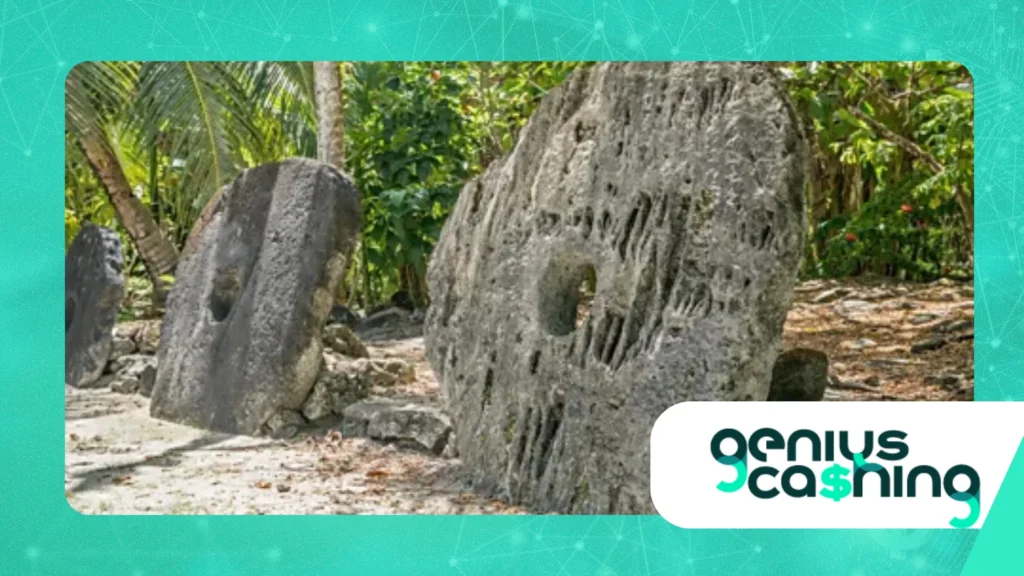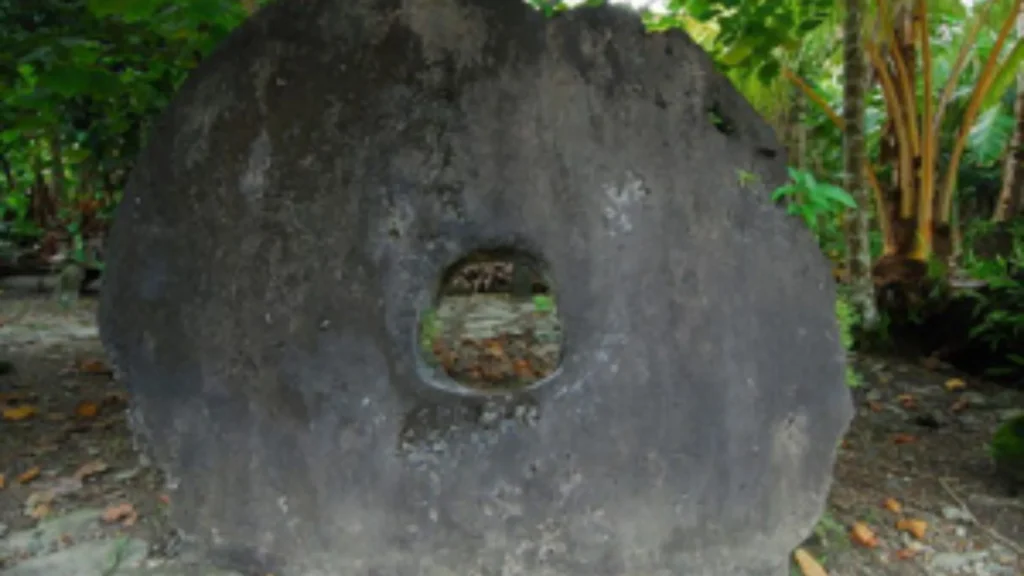The Island That Used 4-Ton Stones as Currency

The tiny Pacific island of Yap provides the most compelling lesson in monetary theory found anywhere on Earth.
Anúncios
Their traditional currency, the colossal Rai stones, makes Yap the fascinating Island That Used 4-Ton Stones as Currency.
These immense, carved limestone discs, some measuring up to 12 feet in diameter, challenge every modern assumption about what money must be. This ancient system offers profound insights into trust, scarcity, and the true nature of value.
For centuries, the Yapese people demonstrated that money is fundamentally an agreed-upon communal record, not merely a physical object.
The sheer logistical absurdity of trading a four-ton rock daily forces us to recognize the brilliance of their decentralized system. Their economic model was one of the world’s original and most stable distributed ledgers.
Anúncios
How Was the Value of Rai Stones Determined and Maintained?
The valuation of Rai stones on the Island That Used 4-Ton Stones as Currency was a complex, public, and culturally embedded process.
Size was only one factor; the true value lay in the stone’s historical narrative and the difficulty of its acquisition.
The Role of Oral History in Valuation
A stone’s value was not static; it increased based on the difficulty and danger of the original voyage to bring it to Yap.
Since the limestone was not native to Yap, the stones had to be quarried hundreds of miles away, primarily on the island of Palau.
The more lives lost or the greater the storms encountered during the perilous sea journey, the higher the stone’s final, publicly verified value.
This oral history functions as a permanent record of expense and sacrifice, establishing a value that goes far beyond mere material weight.
The entire community was involved in hearing and validating the story of each stone’s arrival. This shared, unchangeable history gave the stones their remarkable, intrinsic economic power.
The most famous example involves a massive Rai stone that sank to the bottom of the ocean during transport.
Despite never having arrived on the island, the community collectively agreed that its tragic history of acquisition was valid.
It remained in circulation, being transacted by verbal agreement, proving that ownership, not possession, was the key.
++ What the Titanic Can Teach You About Business Risk
Why Scarcity and Confidence Were Key
The immense difficulty of transporting a new Rai stone acted as a powerful, natural check on inflation. It was virtually impossible to suddenly flood the market with new currency, ensuring its scarcity.
This high barrier to entry maintained the stones’ long-term value, preventing the kind of rapid devaluation seen in many modern fiat systems.
The entire system was predicated on absolute communal confidence and social visibility. When a Rai stone changed hands say, as a dowry or for a land purchase the stone itself rarely moved.
The transfer of ownership was announced publicly, making the new owner common knowledge. The physical location was irrelevant; the collective agreement was everything.

What Economic Principles Did the Island That Used 4-Ton Stones as Currency Pioneer?
The system employed on the Island That Used 4-Ton Stones as Currency was an ancient, brilliant application of economic theory.
It functioned as an effective, if unconventional, system that met all the criteria of a true currency: a store of value, a medium of exchange (for major transactions), and a unit of account.
Also read: The Only Country That Ever Declared Bankruptcy 9 Times
Decentralized Ledger and Consensus
The Yapese model essentially operated as a decentralized, trust-based financial ledger, predating concepts like the modern blockchain by centuries.
All transactions and ownership records were stored not on paper or digital servers, but in the collective, public memory of the islanders. This social consensus acted as the ultimate security system.
Anthropological data supports the idea that this oral consensus was remarkably secure.
Stealing a four-ton rock was logistically impossible, and disputing its ownership was culturally unacceptable once the transfer was publicly acknowledged. This public, shared record made the system highly resistant to fraud.
Read more: How Rich Was Cleopatra, Adjusted for Inflation?
The Problem of External Inflation
The stability of this system was only truly threatened by external interference.
The Irish-American trader David Dean O’Keefe, in the late 19th century, realized he could use modern sailing vessels to import Rai stones more easily from Palau in exchange for local goods. This act dramatically increased the supply.
Although O’Keefe’s stones were often larger and better carved, the Yapese quickly discounted their value because they lacked the crucial component: the history of great sacrifice and effort.
This external mass production caused a form of localized inflation, teaching the Yapese an early lesson about the dangers of easy money creation.
How Does Rai Money Compare to Modern Cryptocurrency?
The unique economic operation of the Island That Used 4-Ton Stones as Currency has led economists and technologists to draw parallels to modern concepts, particularly the blockchain.
While the comparison must be treated carefully, the shared fundamental principles are striking.
Analogy: Rai as the Original Blockchain
The Rai stone system functions much like a decentralized digital ledger, or blockchain. The stone itself is merely the token.
The value and ownership are held in a distributed, public record of transactions that must be verified by the community (consensus).
The effort of transporting the stone is analogous to the ‘Proof-of-Work’ mining concept, requiring verifiable, resource-intensive labor to establish value.
This comparison, while not perfect, effectively illustrates a profound economic truth: the physical form of money is less important than the social contract and verifiable scarcity underpinning it.
The stone’s value resides entirely in the shared, immutable record of the community.
The Decline of Rai for Daily Use
While the US dollar is now the official currency of Yap for daily transactions, the Rai stones still hold their ceremonial and high-value status.
They are still used today for the most significant transfers of wealth, such as the purchase of land, major political alliances, or dowries. This enduring ceremonial use highlights their irreplaceable cultural value.
The shift to the dollar for small transactions began in the 20th century, largely due to the convenience of modern currency and the influence of foreign powers.
However, the largest stones remain in place, standing as visible, powerful markers of wealth and a living museum of monetary history.
| Monetary System | Mechanism for Scarcity/Value | Ledger/Record | Physical Movement for Transaction |
| Yapese Rai Stones | Labor/Risk of Acquisition (Oral History) | Communal, Oral Consensus (Distributed Ledger) | Rarely/Never (Ownership is verbal) |
| Modern Fiat (USD, Euro) | Central Bank Control (Supply is Elastic) | Digital Databases/Government Records | Frequently (Cash/Electronic Transfer) |
| Cryptocurrency (Bitcoin) | Mathematical Proof-of-Work (Code-based Scarcity) | Decentralized Digital Blockchain | None (Digital Transfer) |
Source: Compiled from anthropological and economic studies of Yapese currency and modern monetary theory.
The story of the Island That Used 4-Ton Stones as Currency is far more than a historical oddity; it is a fundamental lesson in economics.
It teaches us that money is simply verifiable information, an abstract concept that requires a social consensus to function.
The Rai stones, immovable and rare, stand as monuments to a system built on mutual trust and transparency.
They remind us that true value is born from scarcity and a publicly acknowledged history, not just metal or paper.
Are we truly more advanced than the Yapese in how we manage our own unstable, rapidly inflating currencies? Share your thoughts on this ancient, genius system below.
Frequently Asked Questions (Duvidas Frequentes)
Where exactly is Yap, the Island That Used 4-Ton Stones as Currency?
Yap is one of the four states of the Federated States of Micronesia, located in the western Pacific Ocean. It is a small island group known globally for its unique currency.
Are the Rai stones still considered legal currency today?
Yes, though the US dollar is used for daily commerce, the Rai stones are still exchanged for major, ceremonial transactions like dowries, land purchases, and social agreements. They retain immense cultural and traditional value.
Why did the Yapese not quarry the stone on Yap itself?
The specific material, a bright, crystalline limestone (aragonite), was not available on Yap.
The necessity of traveling over 280 miles to Palau to quarry the stone created the inherent scarcity and risk that defined the stone’s value.
How could a stone lost at sea still be used as money?
The value of the Rai stone was based on the shared, public knowledge of the extreme effort and risk taken to acquire it.
Since the entire community witnessed the journey and its loss, the ownership record was validly transferred, even without the physical token.
